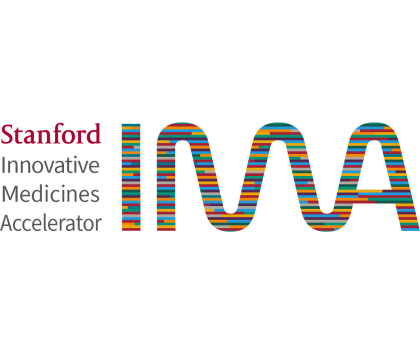2022 Molecular Therapeutics Call for Proposals
The IMA aims to accelerate the translation of scientific discoveries at Stanford University into new medicines through prototyping of innovative therapeutics and vaccines while enabling hypothesis-driven studies that impact human health. Through this broad call for proposals, the IMA is soliciting Letters of Intent (LOI) for projects that fall under one of the following modules:
- High-Throughput Screening Assay Development: Design, optimization, and miniaturization of biochemical or cell-based assays in 384-well microplate format for use in high-throughput, small-molecule screening. Competitive projects require a strong, novel therapeutic hypothesis and aim to identify small molecule leads for a defined molecular target.
- Small Molecule Drug Prototyping: Engineering small molecule leads to improve their potency, selectivity, pharmacokinetics and/or pharmacodynamics. Competitive projects will have a strong therapeutic hypothesis, a novel biological target, one or more small molecule leads as starting points for medicinal chemistry, and appropriate assays for lead optimization.
- Prototyping of Protein Therapeutics: Discovery and/or engineering of a monoclonal antibody with sufficiently promising properties to advance as a drug prototype. Projects requiring engineering of non-antibody protein leads with therapeutic potential are also eligible to apply. Competitive projects will have a strong therapeutic hypothesis, a novel biological target, and assays for protein drug prototyping.
Basic research, including target identification, is outside the scope of the current LOI solicitation.
Support Provided:
- High-Throughput Screening Assay Development: Selected projects will receive access to the Sarafan ChEM-H / CSB High-Throughput Screening Knowledge Center (HTSKC) facility. Support will include access to HTS compound libraries, instrumentation fees, associated consumables, expert training, and assay development guidance for high-throughput screening projects.
- Small Molecule Drug Prototyping: Selected projects will receive access to the Sarafan ChEM-H Medicinal Chemistry Knowledge Center (MCKC) to facilitate the design, synthesis, and screening of novel small molecules to identify lead drug prototypes. Support will focus on improving pharmacodynamics and pharmacokinetics of established molecular targets.
- Prototyping of Protein Therapeutics: Selected projects will receive access to the Sarafan ChEM-H Protein Engineering Knowledge Center (PEKC) facility for tasks including discovery of monoclonal antibodies to serve as a therapeutic lead, structure-based and/or evolutionary-guided optimization of a lead antibody or non-antibody protein therapeutic, and recombinant protein production for structure-activity relationship analysis.
- Animal Pharmacology: Projects requiring the establishment and/or scale-up of animal models to achieve their goals will receive appropriate support of this nature from IMA’s animal pharmacology and veterinary services experts.
Each of the above modules is led by experienced faculty and senior research staff members, including Knowledge Center heads, who will collaboratively help the PI of awarded projects to formulate a goal- and milestone-driven project plan. The IMA will provide support throughout the lifetime of the project. Further details regarding specific roles and responsibilities of personnel support and financial allocations will be elaborated in individual award letters issued to selected projects. The specific level of support will vary by project need.
All Stanford faculty with PI eligibility are eligible to apply.
LOIs should be submitted as single PDF files containing the following materials in the order indicated below. All documents must be single-spaced, Arial 11-point font with 1-inch margins.
- Title page (1 page): Project title, Investigator name(s), department, address, phone number, email address, and a project summary for a lay audience (150 words max).
- Letter of Intent (3 pages maximum) –
- High-Throughput Screening Assay Development: Briefly describe the therapeutic hypothesis and the case for the biological target of the anticipated high-throughput assay development effort. Provide a technical summary of the assay you wish to miniaturize as well as potential secondary assays. Include details on the availability of protein structure and access to materials required for the assay (cell lines, purified proteins, etc).
- Small Molecule Drug Prototyping: Briefly describe the therapeutic hypothesis and justification for the biological target of the anticipated small molecule prototyping effort. Identify milestones that would overcome a specific hurdle toward Drug Prototyping. Describe studies that would enable de-risking of the foundational technology necessary for pre-clinical development.
- Prototyping of Protein Therapeutics: Briefly describe the medical need the project seeks to address and the case for the biological target of the anticipated drug prototyping effort. Where relevant, briefly describe the structure and/or properties of the bioactive protein that serves as the starting point of your project. Briefly describe the biological assays that will be required to optimize the compound. Emphasize what is novel about your approach and highlight potential competitor molecules.
3. NIH-format biosketch for each investigator
LOIs should be submitted directly through SlideRoom (link below). Once in the portal, you will be directed to select one of the three IMA modules. Please select the one most appropriate for your proposed research. You do not need to submit your applications to your Research Process Manager (RPM) in RMG or through your Office of Sponsored Research (OSR) Contract and Grant Officer (CGO) for their approval at this time.
Depending on the nature and requirements of each project, the IMA will provide access to strategic alliances and vetted contract research organizations (CROs) to support awarded projects. PIs will also receive access to the IMA’s Pharmacology module for in vitro and in vivo PK/PD analysis to evaluate the efficacy of the most promising drug prototypes in a suitable disease model.
